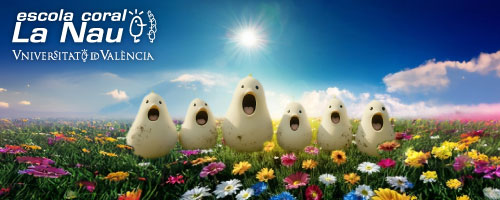This educational activity for children started in October 2002. The Choral School of La Nau, directed by Mònica Perales i Massana, was created to provide musical education for children in the UV. On the basis that songs are the main element for structuring good musical training, it is an excellent voluntary mean of expression that constitutes an important element of human education. All children have the ability to sing. Singing is a natural activity, alongside movement and language. Therefore, singing should become a daily activity. Songs develop audio perceptions and emotional, physical and mental experiences, as long as they are well taught. In addition, chorus are understood as a team work awakens solidarity: listen, see and live together.
It should be outlined that the School aims to promote the use of the Valencian language and music, and its repertoire includes popular and authored works, always for children voices.
Since 2005, music reading classes were incorporated in the Garbí and Tramuntana groups. The classes are led by Inmaculada Mirapeix and intend to improve the pedagogical quality of the School.
The school rehearses regularly at the Principal Peset Hall of Residence, where most concerts have been played, although it has played in different facilities of the Universitat de València: Auditorium Joan Plaça of the Botanical Garden, Chapel of the Sapiència, and Charles Darwin Room of the Burjassot Campus. Additionally, it has represented the Universitat de València in important auditoriums of the Valencian Community: Auditorium TAMA of Aldaia, Roman Theatre of Sagunt, Palau de la Música de València, Palau de les Arts Reina Sofia, etc.
Since 2003, the Choral School La Nau carries out a yearly meeting in collaboration with other choral schools (Escola Coral de la Unió Musical d’Almansa, Schola Cantorum d’Aldaia and Cor Melisma de l’Escola de Música Camp de Morvedre) to play music together, especially a different repertoire to the one they are used to play. This experience has released several works such as: Reimund Hess’ Les tres locomotores, Diego Alamar’s Issunboshi and La quimera del tiempo, Josep R. Gil-Tàrrega’s El Patge Saguntí and L´origen dels núvols, Sonia Megías’ Érase una vez en Almansa, Juan Luis Martínez’s Definitio or Frederic Mompou’s L´ocell daurat, among others.
It is a well consolidated teaching and music challenge that does not only have an artistic objective, but also a social one. It consists in encouraging the children of the members of the Teaching, researching and administrative staff of the Universitat de València and related groups such as Alumni UV to participate actively in UV activities. In addition, the gates of our school are opened to the general public, which definitely defines the image of the Universitat as a centre that creates and promotes culture.






